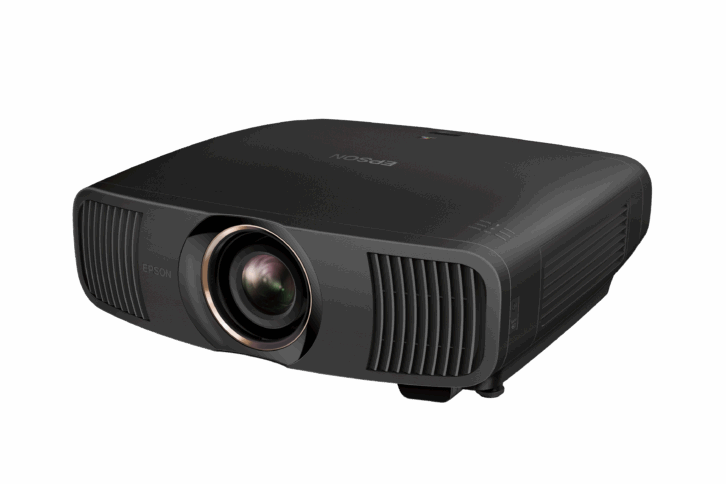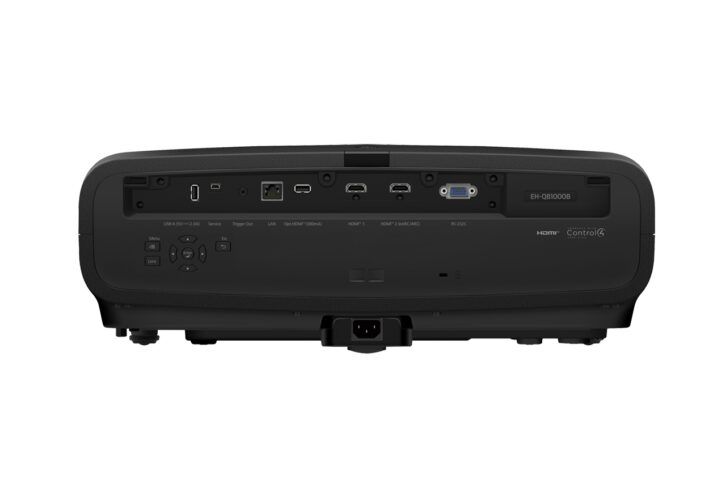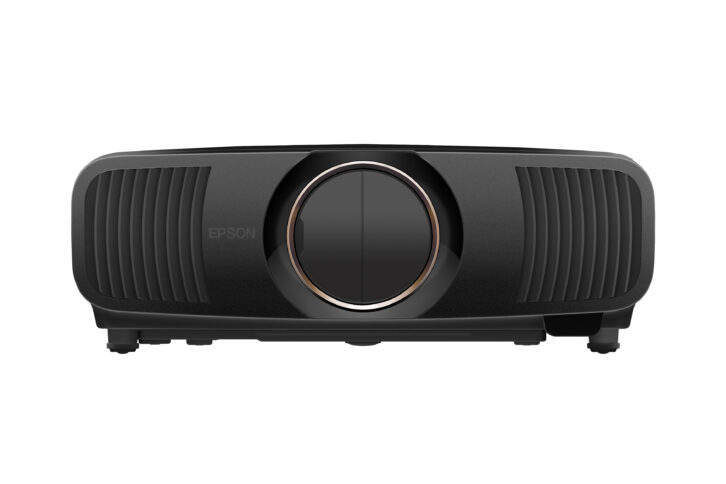
Menu
For multi-use installations that will be competing with ambient lighting, the QB1000 offers a compelling argument over a direct view display, with images only getting better when the lights go down.
Epson’s new Premium Residential models QB1000, QL3000, and QL7000 launched at CEDIA Expo 2024. All these models are designed to take Epson’s high-brightness commercial projection expertise to the upscale residential market. The QB1000 (reviewed here) clocks in at 3300 lumens, the QL3000 at 6000, and the QL7000 at an eye-melting 10,000.
Considering that projectors priced comparably and even up to twice the QB1000 generally have roughly 1000 lumens less brightness, that is quite a benchmark. And the QL7000 is not only significantly lower-priced than other 10,000-lumen projectors, but it is also significantly smaller, lighter, and quieter than other models, meaning it likely wouldn’t need to be housed in a special projection room or hush box.
Epson’s senior product manager of home entertainment, Melvin Diaz, said that the Q-Series’ high brightness is designed to deliver in three key areas: [1] Deliver a larger-scale viewing experience than traditional flat panel TVs; [2] Enable installations in brighter, mixed-use environments, and [3] Drive an impactful HDR experience, all within a sleek, design-conscious form factor.
To be more multi-use friendly, all three of the models are available in either matte black or white case finishes, and Epson sent along the white model for review. Since my projector is in my great room, the white Epson was definitely more décor-friendly than the black projector I currently have hanging.
While the QB1000 is an inch less deep (without the rear cable cover attached) than both similar-priced Sony and JVC models — which are currently the two “world’s smallest” native 4K laser projectors — it is more than 2 inches wider. So, out of the box, it looked slightly bigger even though it is roughly the same height. But it has soft, rounded edges that help to mitigate the size.

Diaz said that Epson’s Q-Series home projectors are designed to be quieter than commercial models, requiring a different chassis and cooling design. I liked that the cooling system draws air in through the sides of the unit and exhausts it out the front, letting you place the projector right up against the back wall if needed without any fear of overheating.
As with all of Epson’s 4K projectors, the QB1000 is a 3-chip, 3LCD design that uses three individual LCD driver chips and three individual LCD panels, each dedicated for red, green, and blue primary colors to display 100% of the signal for every frame. However, these are all 1920×1080 resolution chips, so getting the full 8.29 million pixels on screen for 3840×2160 4K resolution requires the use of a technique called “pixel-shifting” and a Precision Shift Glass Plate that Epson refers to as “4K display technology.”
This means that every pixel’s image is rapidly shifted four times diagonally and horizontally, allowing each individually addressable pixel to be displayed. This process happens at an extremely high cycle rate, quadrupling the visible pixels on screen to produce the 8.29 million pixels of 4K. This is opposed to the native 4K chips used by manufacturers like Sony and JVC, which don’t require pixel-shifting technology.
A couple of noted bits of technology make these new models possible. One is a new-generation, high-efficiency laser light source, which can achieve higher brightness in a smaller size. Epson claims that the laser light engine is 75% smaller, as well as quieter than previous designs, again making them more usable in a wider number of installation applications.
The QB1000 claims a sub 32 dB fan noise output level at 100% laser brightness, which drops quieter when at 85%, and as quiet as 22 dB at 50% brightness.
Another big improvement in this lineup is Epson’s new proprietary QZX Picture Processor, the company’s most powerful video processing technology to date. This 32-bit chip handles real-time color, dynamic contrast, scene adaptive gamma, HDR, 4K pixel-shifting, frame interpolation, dynamic tone mapping, and resolution super-sampling to most accurately and faithfully reproduce the source material.
Connections are all on the back of the unit, which keeps the sides clean. If you’re a stickler for no visible wires, the unit comes with a rear panel cover that will conceal all the connections, but it does add about 2 inches to the depth. And while they will likely be used sparingly, I did love that Epson included a full suite of D-pad controls on the back of the unit, including a Menu and Lens button that will allow you to perform all operations directly from the unit itself. A menu setting even lets you invert the direction buttons on the unit when controlling the OSD from the unit when it is ceiling-mounted. Smart!
The projector includes two HDMI 2.1 inputs that are full 40 Gbps bandwidth and can accept both 2K/120 and 4k/120 signals. Interestingly, HDMI 2 is eARC-capable, letting you connect the projector directly to a soundbar or other system, like Sony’s Theater Quad. Also interesting is that the eARC connection supports HDMI-CEC control, so you could control a connected CEC-capable device.
The HDMI inputs feature ALLM (Auto Low Latency Mode) for gamers, with a reported input lag time below 20ms.

With its UltraBlack technology, a proprietary compensation filter that controls the polarization of light, the QB1000 can produce a Dynamic Contrast Ratio exceeding 5,000,000:1.
But the big new feature to the QB1000 is video processing that analyzes content on a frame-by-frame basis in real-time, called Dynamic Tone Mapping (DTM). In addition, the QB1000 also supports HDR10+, a dynamic HDR format akin to Dolby Vision. HDR10+ had previously been reserved for a handful of UHD Blu-ray disc releases; however, several major streaming platforms such as Netflix, Disney Plus, Apple TV, and Prime Video have started streaming content coded with HDR10+ metadata, so this feature could become a compelling purchasing driver. It also supports the HLG — Hybrid Log Gamma — HDR standard.
Along with the HDMI connections, there is an RJ45 for connection to a LAN, a USB-A with 5V/2A to power a streaming device, a USB-A with 300mA to power an Optical HDMI cable, a mini-USB for service and backups/restores, an RS-232 DB9 connection, and a 12-volt mini-jack trigger, along with a detachable power connection. The trigger output is configurable to be always on, useful for dropping a motorized screen, or only on when an Anamorphic mode is selected, useful for triggering a lens sled.
In addition to front and rear IR signal sensors, the QB1000 can be fully set up and controlled via IP, and supports PJLink, Control4’s SDDP protocol, and Crestron integration. The Control4 control library offers direct access to virtually every command and setting you might want, letting you give customers access — or pre-programmed commands — to switch to the ideal picture mode or setting when watching different sources, aspects, or resolutions.

The QB1000 delivers a sharp, detailed picture with great edge-to-edge focus. Things like the instrument readouts and displays in the Darkstar cockpit in the opening of Top Gun: Maverick, or words and files on computer monitors in Zero Dark Thirty, were all visible, and there were tons of fine details in the intricate costumes of the dancing warriors on the boats as we first come into Wakanda in Black Panther. Large cityscapes and broad vistas also revealed loads of detail, with sharp resolution and crisp focus at all points on the screen.
I was eager to see how the 4K pixel-shifting affected images compared to my native 4K Sony, so I started with a variety of test patterns from the new Spears & Munsil Ultra HD Benchmark discs. For the most part, the pixel-shifting handled these without issue; however, there were times when there would be some slight strobing or flashing in the very finely detailed 1:1-pixel patterns.
The Epson QB1000 sets a new benchmark in the lumens-to-dollars category, delivering up to 3300 lumens to produce a dynamic HDR image. For multi-use installations that will be competing with ambient lighting, it offers a compelling argument over a direct view display, with images only getting better when the lights go down!
Product Specs:
Dimensions: 20.5 x 7.6 x 16.6-inches (WxHxD, excluding rear cable cover); Weight: 28.2 pounds
Phone: (760) 799-0881
Email: Sales@AVIR.com
Ask for Charley or Yasin.
Services:
Home Cinema
Automation
Lighting
Shading
Music
Security
Networking
Proudly serving the entire Coachella Valley and surrounding areas:
Banning
Beaumont
Bermuda Dunes
Big Bear
Cathedral City
Coachella
Idyllwild
Indian Wells
Indio
Joshua Tree
La Quinta
Lake Arrowhead
Moreno Valley
Murrieta
Palm Desert
Palm Springs
Rancho Mirage
Redlands
Riverside
San Bernardino
Temecula
Thermal
Thousand Palms
Yucaipa
Yucca Valley